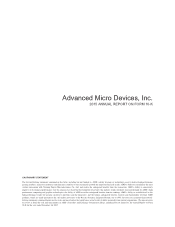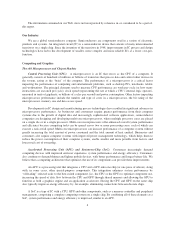AMD 2015 Annual Report Download - page 13
Download and view the complete annual report
Please find page 13 of the 2015 AMD annual report below. You can navigate through the pages in the report by either clicking on the pages listed below, or by using the keyword search tool below to find specific information within the annual report.refers to a set of advanced hardware and software technologies that enable discrete AMD GPUs, working in
concert with the CPU, to accelerate computational tasks beyond traditional CPU processing by utilizing the vast
number of discrete GPU cores while working with the CPU to process information cooperatively. In addition,
computing devices with HSA features run computationally-intensive tasks more efficiently, which we believe
provides a superior application experience to the end user. Moreover, heterogeneous computing allows for the
elevation of the GPU to the same level as the CPU for memory access, queuing and execution.
Our Graphics Products
Graphics is a fundamental component of almost everything we create and can be found in an APU, GPU,
SoC or a combination of a GPU with one of the other foregoing products working in tandem. Our customers
generally use our graphics solutions to increase the speed of rendering images and to help improve image
resolution and color definition. We develop our graphics products for use in various computing devices and
entertainment platforms, including desktop PCs, notebook PCs, 2-in-1s and professional workstations. With each
of our graphics products, we have available drivers and supporting software packages that enable the effective
use of these products under a variety of operating systems and applications. In addition, our recent generation
graphics products have Linux®driver support.
Discrete Desktop and Notebook Graphics. Our discrete GPUs for desktop and notebook PCs enable next
generation APIs like DirectX®12 and Vulkan™, support new displays using Freesync™ technology, and are
uniquely positioned to drive the next visual revolution of virtual reality (VR) in PC platforms. Our products
include AMD Radeon™ R5, R7 and R9 series graphics. In June 2015, we introduced the new AMD Radeon™
R9 Fury X and R9 Fury graphics, the AMD Radeon R7 300 and R9 300 series graphics as well as the AMD
Radeon M300 series graphics to reinforce our graphics leadership in both power efficiency for notebooks and
best-in class performance for desktops. In August 2015, we introduced the AMD Radeon™ R9 Nano, featuring
on-chip High-Bandwidth Memory (HBM) for 4K gaming performance.
Professional Graphics. Our AMD FirePro™ family of professional graphics products consists of 3D and
2D multi-view graphics cards and GPUs that we designed for integration in mobile and desktop workstations, as
well as commercial PCs. We designed our AMD FirePro 3D graphics cards for demanding applications, such as
those found in the computer aided design (CAD) and digital content creation (DCC) markets, with drivers
specifically tuned for maximum performance, stability and reliability across a wide range of software packages.
We designed our AMD FirePro 2D graphics cards with dual- and quad-display outputs for financial and
corporate environments.
We also provide the AMD FirePro S-Series GPU products for the server market, where we target high
performance computing (HPC) primarily focused on Deep Neutral Networks (DNN), Geosciences, Biosciences,
Academic and Government workloads, and virtual desktop infrastructure (VDI) use cases primarily focused on
workstation-class virtualization, desktop remoting and content streaming workloads. In July 2015, we announced
our new AMD FirePro™ S9170 server GPU, designed for high performance compute (HPC) environments. In
December 2015, we launched the AMD FirePro W4300 graphics card designed for Computer-Aided Design
(CAD) for both small and full-size workstations.
Enterprise, Embedded and Semi-Custom
The Enterprise, Embedded and Semi-Custom Markets
Server. A server is a computer system that performs services for connected customers as part of a client-
server architecture. Many servers are designed to run an application or applications often for extended periods of
time with minimal human intervention. Examples of servers include web servers, e-mail servers and print
servers. These servers can run a variety of applications, including business intelligence, enterprise resource
planning, customer relationship management and advanced scientific or engineering models to solve advanced
7
























